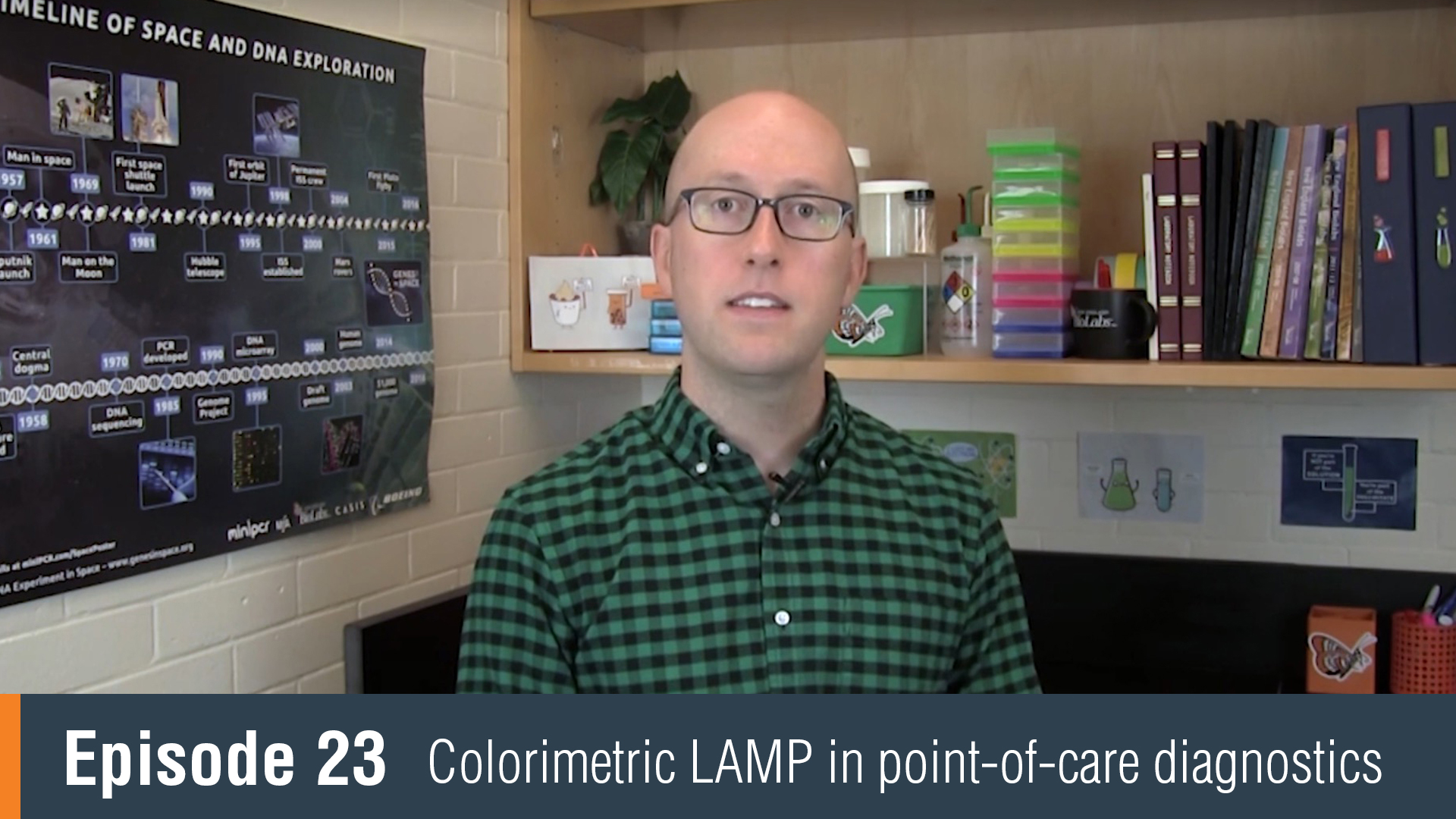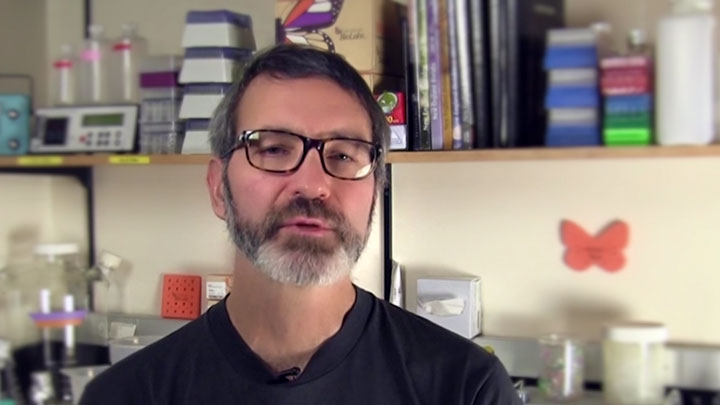NEB® TV Ep. 3 – DNA Amplification
Script
Deana Martin:
Welcome to NEB TV. Today, I have with me Nathan Tanner, one of our staff scientists. We brought Nathan in today, because he has some really exciting work that we wanted to share with you.
Nathan Tanner:
Thanks, Deana. I work on DNA polymerases and amplification. I'm going to tell you a little bit about colorimetric method we've developed for amplification detection. Then, you'll hear about how it's applied in the field from Tilde. Then Nicole, one of our application scientists, will tell you about high-fidelity polymerases, PCR, and how we handle tech support inquiries.
Deana Martin:
Great, let's get started.
Nathan Tanner:
So, we do a lot of work on DNA polymerases and amplification methods using isothermal amplification. Isothermal is very interesting to us, because it uses a unique set of reagents, and you get a lot of the benefits for detecting DNA or RNA like you would in PCR, but you can do it much more simply. Don't have to raise the temperature up and down, so the equipment can be very simple, to non-existent.
So, we look at the isothermal polymerases, we want to see how they do in field or point-of-care assays, and we were checking out how the polymerases did without any buffer, or when the pH changes a lot. It turns out, the enzymes are really robust. Buffer doesn't matter, as long as you get the pH in the range of 7 to 10. So, if you do these reactions, you can get a pH drop of about 2-3 units. This happens because for every nucleotide incorporation, polymerase produces a proton.
So, we do these reactions get a big pH drop, and by pairing the buffer-free reactions with a pH indicator, of which there are plenty, we can get a nice, visually striking, robust color change, pink to yellow or whatever color we want, in just a few minutes. So it's a very sensitive assay that we can do visually in just a couple minutes.
Tilde Carlow:
My name is Tilde Carlow. I'm the scientific director of the division of genome biology. My lab conducts research on neglected tropical diseases. Some of these diseases are caused by small, thread-like parasitic worms transmitted by a number of different blood-sucking insects.
Accurate parasite detection in both the human host and the insect vector is needed to be able to efficiently control these diseases. Currently available tools are limited because of their lack of specificity and sensitivity, as well as they are cost prohibitive. The goal of my lab is to bring simple and accurate diagnostic tools to the field.
At the moment, we are focusing our effort on isothermal DNA amplification technologies, in particular LAMP or loop-mediated amplification. This is a very simple and robust method that can easily detect parasite DNA in both the human host and insect vector.
We are using pH sensitive dyes in order to detect the amplification product. These are so simple and easy to use, and we can detect the amplification product by a simple color change easily detectable by the naked eye.
We are currently working with scientists and public health officials in the areas where these tropical diseases are endemic, with the hope of using these newly developed tools in their control programs moving forward.
Nicole Nichols:
The fidelity of a DNA polymerase refers to its ability to accurately replicate a template. A critical aspect of this is the ability of the DNA polymerase to read a template strand, select the appropriate nucleoside triphosphate, also called a nucleotide, and insert the correct nucleotide at the 3' primer terminus, such that canonical Watson-Crick base pairing is maintained.
The rate of misincorporation, incorporating the incorrect nucleotide, is known as a polymerase's error rate. High-fidelity DNA polymerases have several checkpoints to protect against making and propagating mistakes while copying DNA. They have a significant binding preference for the correct versus the incorrect nucleotide during polymerization, and if an incorrect nucleotide does bind in the polymerase active site, incorporation is slowed due to the sub-optimal architecture of the active site complex. This time increases the opportunity for the incorrect nucleotide to dissociate before incorporation.
However, if an incorrect nucleotide is inserted, proofreading DNA polymerases have an extra line of defense. They can sense the perturbation caused by the mispaired bases, and move the 3' end of the growing DNA chain into a proofreading 3-to-5' exonuclease domain. There, the incorrect nucleotide is removed by the 3-to-5' exonuclease activity, before the chain is moved back into the polymerase domain, where polymerization can continue with the correct nucleotide.
One of the tech calls we get with some regularity is a customer who's calling us, having difficulty amplifying their GC-rich target. What we usually find is that they're using their favorite polymerase, and when they have trouble with that they'll turn to the web or something that someone down the hall has used with success.
The other day I got a call from a customer who'd had some trouble amplifying a GC-rich target, trying to amplify a promoter from human genomic DNA. He'd been using his favorite hot-start Taq, and no matter what he tried, we was seeing a smear on his gel.
He called us, because someone in the next lab had shared her vial of Q5 Master mix with him, because it had worked for her. He tried Q5, but unfortunately this also hadn't worked.
So, I started asking questions about his reaction conditions. It turned out that he had been using his Taq cycling conditions with Q5, and we know that this isn't ideal. I directed him to the TM Calculator on our neb.com website, where he was able to see what I was describing. Together, we used the test primer data on the site to determine an appropriate annealing temperature for both Q5 and Taq. He was really surprised to see that they differed by over 15°.
We went over the rest of his reaction conditions to see if there were any other adjustments that could be made to his next reaction to ensure success. It was a good conversation, and the fact that he was willing to share reaction details really made it helpful and easy to get to the bottom of his particular issues.
I always ask customers to call me back if my recommendations don't work, so we can continue to troubleshoot, but this customer went the extra mile. He reached out the next day to let me know he had seen a big, fat band on his gel in both the Q5 reactions, so that made us both really happy.
Deana Martin:
So, Nathan, thanks for swinging by the lab.
Nathan Tanner:
Thanks for having me.
Deana Martin:
Great, and as always, let us know if you have any suggestions for future episodes.
Related Videos
-

NEB® TV Ep. 23 – Colorimetric LAMP in point-of-care diagnostics -

Restriction Enzymes in Isothermal Amplification -

Why Choose Q5® High-fidelity Polymerase?

